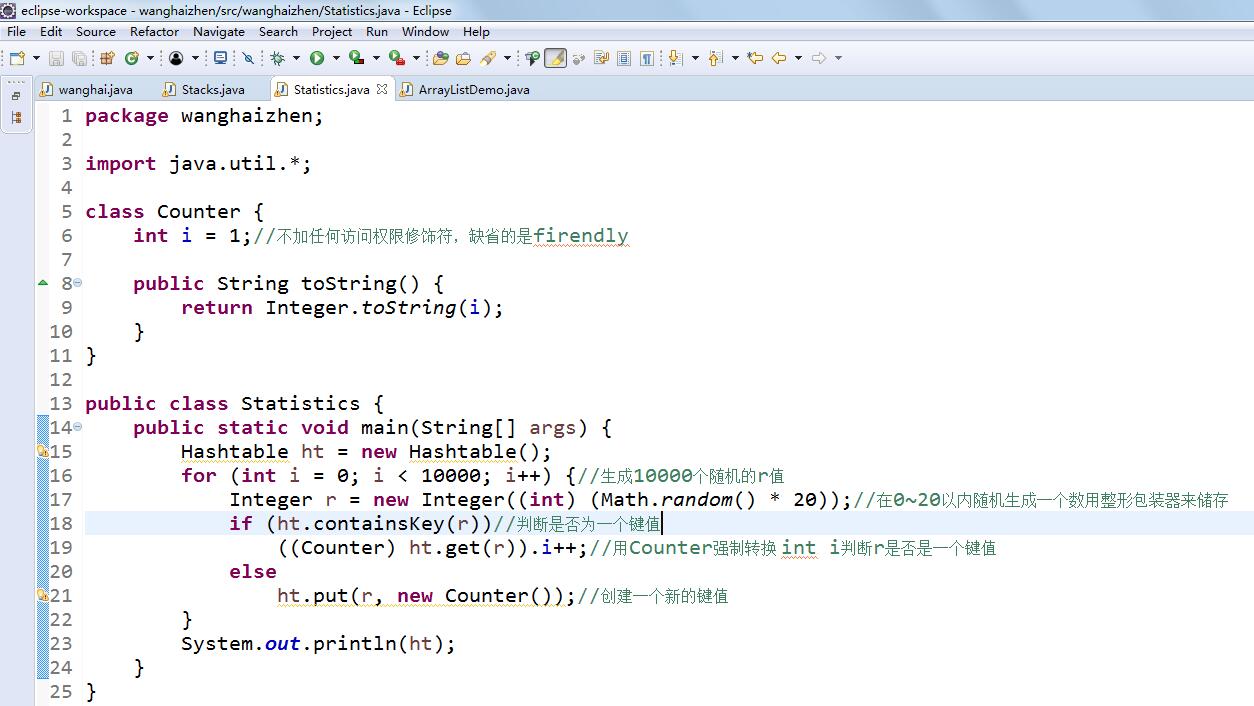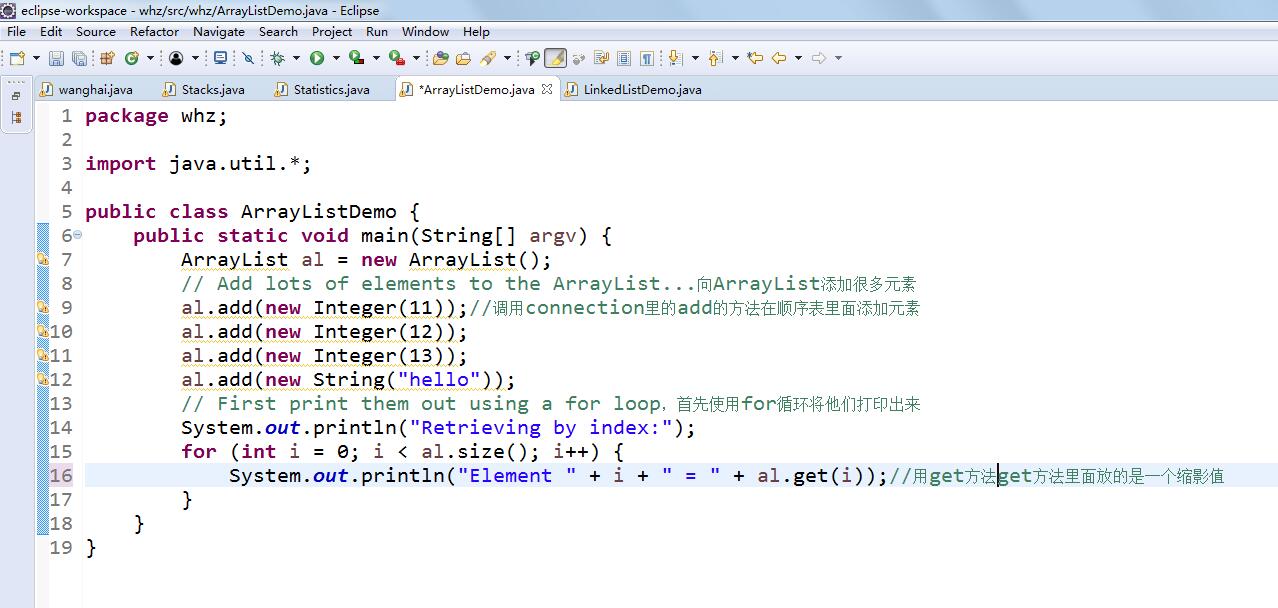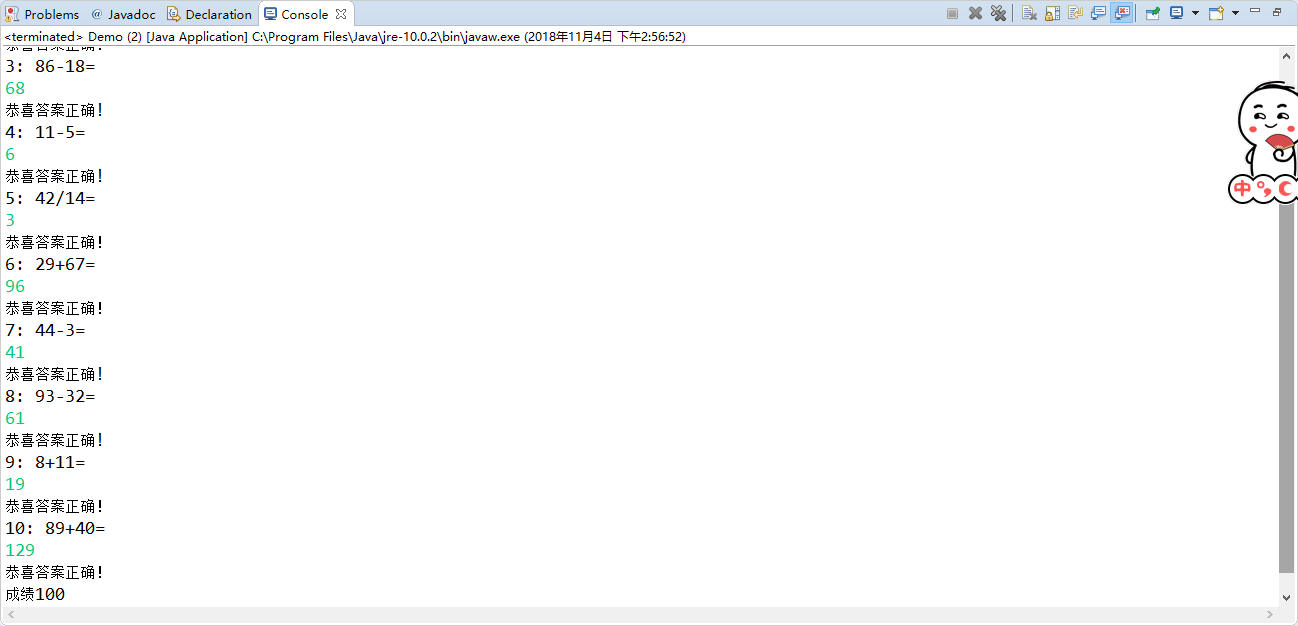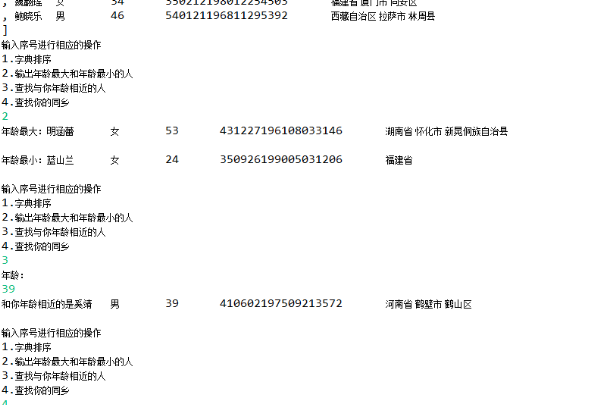201771010124 王海珍 《面向对象设计java》第十一周总结
第一部分 理论部分
本章节的主要内容为集合
(1)Java集合框架;
a:将集合的接口与实现分离;
b:Collection接口,集合类的基本接口。这个接口有两个基本方法
public interface Collection<E>
{
boolean add (E element);
Iterator<E> iterator();
.....
}
c:迭送器;
d:泛型使用方法,Collection与Iterator都是泛型接口;
e:集合框架中的接口,集合有两个基本接口 Collection和Map;
(2)具体的集合;
a:链表,尽管数组在连续的存储位置上存放对象引用,但链表却将每个对象存放在独立的结点中。
b:数组列表;
c:散列表;散列表又称为哈希表。散列表算法的基本思想是:以结点的关键字为自变量,通过一定的函数关系(散列函数)算出对应的函数值,以这个值作为该结点存储在散列表的地址。
散列表中的元素存放太满,就必须进行再散列,将产生一个新的散列表,所有元素存放到新的散列表中,原先的散列表将被删除。在Java语言中,通过负载因子(loadfactor)来决定何时对散列表进行再散列。例如:如果负载因子是0.75,当散列表中已经有75%的位置已经放满,那么将进行再散列。
负载因子越高(越接近1.0),内存的使用效率越高,元素的寻找时间越长。负载因子越低(越接近0.0),元素的寻找时间越短,内存浪费越多。
HashSet类的缺省负载因子是0.75。
d: 队列和双端队列
队列(Queue)是限定所有的插入只能在表的一端进行,而所有的删除都在表的另一端进行的线性表。
表中允许插入的一端称为队尾(Rear),允许删除的一端称为队头(Front)。
队列的操作是按先进先出(FIFO)的原则进行的。
队列的物理存储可以用顺序存储结构,也可以用链式存储结构。
(3)映射;
a:基本映射操作;
b:更新映射项;
c:映射视图;
d:弱散列映射;
e:链接散列集与映射;
f:枚举集与映射;
(3)视图与包装器;
a:轻量级集合包装器;
b:子范图;
c:不可修改的视图;
d:同步视图;
e:受查视图;
f:关于可操作的说明;
(4)算法;
(5)遗留的集合。
第二部分、实验目的与要求
(1) 掌握Vetor、Stack、Hashtable三个类的用途及常用API;
(2) 了解java集合框架体系组成;
(3) 掌握ArrayList、LinkList两个类的用途及常用API。
(4) 了解HashSet类、TreeSet类的用途及常用API。
(5)了解HashMap、TreeMap两个类的用途及常用API;
(6) 结对编程(Pair programming)练习,体验程序开发中的两人合作。
2、实验内容和步骤
实验1: 导入第9章示例程序,测试程序并进行代码注释。
测试程序1:
l 使用JDK命令运行编辑、运行以下三个示例程序,结合运行结果理解程序;
l 掌握Vetor、Stack、Hashtable三个类的用途及常用API。
|
//示例程序1 import java.util.Vector;
class Cat { private int catNumber;
Cat(int i) { catNumber = i; }
void print() { System.out.println("Cat #" + catNumber); } }
class Dog { private int dogNumber;
Dog(int i) { dogNumber = i; }
void print() { System.out.println("Dog #" + dogNumber); } }
public class CatsAndDogs { public static void main(String[] args) { Vector cats = new Vector(); for (int i = 0; i < 7; i++) cats.addElement(new Cat(i)); cats.addElement(new Dog(7)); for (int i = 0; i < cats.size(); i++) ((Cat) cats.elementAt(i)).print(); } } |
|
//示例程序2 import java.util.*;
public class Stacks { static String[] months = { "1", "2", "3", "4" };
public static void main(String[] args) { Stack stk = new Stack(); for (int i = 0; i < months.length; i++) stk.push(months[i]); System.out.println(stk); System.out.println("element 2=" + stk.elementAt(2)); while (!stk.empty()) System.out.println(stk.pop()); } } |
|
//示例程序3 import java.util.*;
class Counter { int i = 1;
public String toString() { return Integer.toString(i); } }
public class Statistics { public static void main(String[] args) { Hashtable ht = new Hashtable(); for (int i = 0; i < 10000; i++) { Integer r = new Integer((int) (Math.random() * 20)); if (ht.containsKey(r)) ((Counter) ht.get(r)).i++; else ht.put(r, new Counter()); } System.out.println(ht); } } |
测试结果如下所示



测试程序2:
l 使用JDK命令编辑运行ArrayListDemo和LinkedListDemo两个程序,结合程序运行结果理解程序;
|
import java.util.*;
public class ArrayListDemo { public static void main(String[] argv) { ArrayList al = new ArrayList(); // Add lots of elements to the ArrayList... al.add(new Integer(11)); al.add(new Integer(12)); al.add(new Integer(13)); al.add(new String("hello")); // First print them out using a for loop. System.out.println("Retrieving by index:"); for (int i = 0; i < al.size(); i++) { System.out.println("Element " + i + " = " + al.get(i)); } } } |
|
import java.util.*; public class LinkedListDemo { public static void main(String[] argv) { LinkedList l = new LinkedList(); l.add(new Object()); l.add("Hello"); l.add("zhangsan"); ListIterator li = l.listIterator(0); while (li.hasNext()) System.out.println(li.next()); if (l.indexOf("Hello") < 0) System.err.println("Lookup does not work"); else System.err.println("Lookup works"); } } |
测试结果如下所示


l 在Elipse环境下编辑运行调试教材360页程序9-1,结合程序运行结果理解程序;
package linkedList;
2
3 import java.util.*;
4
5 /**
6 * This program demonstrates operations on linked lists.
7 * @version 1.11 2012-01-26
8 * @author Cay Horstmann
9 */
10 public class LinkedListTest
11 {
12 public static void main(String[] args)
13 {
14 List<String> a = new LinkedList<>();
15 a.add("Amy");
16 a.add("Carl");
17 a.add("Erica");
18
19 List<String> b = new LinkedList<>();
20 b.add("Bob");
21 b.add("Doug");
22 b.add("Frances");
23 b.add("Gloria");
24
25 // merge the words from b into a
26
27 ListIterator<String> aIter = a.listIterator();
28 Iterator<String> bIter = b.iterator();
29
30 while (bIter.hasNext())
31 {
32 if (aIter.hasNext()) aIter.next();
33 aIter.add(bIter.next());
34 }
35
36 System.out.println(a);
37
38 // remove every second word from b
39
40 bIter = b.iterator();
41 while (bIter.hasNext())
42 {
43 bIter.next(); // skip one element
44 if (bIter.hasNext())
45 {
46 bIter.next(); // skip next element
47 bIter.remove(); // remove that element
48 }
49 }
50
51 System.out.println(b);
52
53 // bulk operation: remove all words in b from a
54
55 a.removeAll(b);
56
57 System.out.println(a);
58 }
59 }

l 掌握ArrayList、LinkList两个类的用途及常用API。
测试程序3:
l 运行SetDemo程序,结合运行结果理解程序;
|
import java.util.*; public class SetDemo { public static void main(String[] argv) { HashSet h = new HashSet(); //也可以 Set h=new HashSet() h.add("One"); h.add("Two"); h.add("One"); // DUPLICATE h.add("Three"); Iterator it = h.iterator(); while (it.hasNext()) { System.out.println(it.next()); } } } |
测试结果如下所示
 l
l
在Elipse环境下调试教材365页程序9-2,结合运行结果理解程序;了解HashSet类的用途及常用API。
package set;
import java.util.*;
/**
* This program uses a set to print all unique words in System.in.
* @version 1.12 2015-06-21
* @author Cay Horstmann
*/
public class SetTest
{
public static void main(String[] args)
{
Set<String> words = new HashSet<>(); // HashSet implements Set
long totalTime = 0;
try (Scanner in = new Scanner(System.in))
{
while (in.hasNext())
{
String word = in.next();
long callTime = System.currentTimeMillis();
words.add(word);
callTime = System.currentTimeMillis() - callTime;
totalTime += callTime;
}
}
Iterator<String> iter = words.iterator();
for (int i = 1; i <= 20 && iter.hasNext(); i++)
System.out.println(iter.next());
System.out.println(". . .");
System.out.println(words.size() + " distinct words. " + totalTime + " milliseconds.");
}
}
测试结果如下所示

l 在Elipse环境下调试教材367页-368程序9-3、9-4,结合程序运行结果理解程序;了解TreeSet类的用途及常用API。
package treeSet;
import java.util.*;
/**
* An item with a description and a part number.
*/
public class Item implements Comparable<Item>
{
private String description;
private int partNumber;
/**
* Constructs an item.
*
* @param aDescription
* the item's description
* @param aPartNumber
* the item's part number
*/
public Item(String aDescription, int aPartNumber)
{
description = aDescription;
partNumber = aPartNumber;
}
/**
* Gets the description of this item.
*
* @return the description
*/
public String getDescription()
{
return description;
}
public String toString()
{
return "[description=" + description + ", partNumber=" + partNumber + "]";
}
public boolean equals(Object otherObject)
{
if (this == otherObject) return true;
if (otherObject == null) return false;
if (getClass() != otherObject.getClass()) return false;
Item other = (Item) otherObject;
return Objects.equals(description, other.description) && partNumber == other.partNumber;
}
public int hashCode()
{
return Objects.hash(description, partNumber);
}
public int compareTo(Item other)
{
int diff = Integer.compare(partNumber, other.partNumber);
return diff != 0 ? diff : description.compareTo(other.description);
}
}
package treeSet;
import java.util.*;
/**
* This program sorts a set of item by comparing their descriptions.
* @version 1.12 2015-06-21
* @author Cay Horstmann
*/
public class TreeSetTest
{
public static void main(String[] args)
{
SortedSet<Item> parts = new TreeSet<>();
parts.add(new Item("Toaster", 1234));
parts.add(new Item("Widget", 4562));
parts.add(new Item("Modem", 9912));
System.out.println(parts);
NavigableSet<Item> sortByDescription = new TreeSet<>(
Comparator.comparing(Item::getDescription));
sortByDescription.addAll(parts);
System.out.println(sortByDescription);
}
}
测试结果如下所示

测试程序4:
l 使用JDK命令运行HashMapDemo程序,结合程序运行结果理解程序;
|
import java.util.*; public class HashMapDemo { public static void main(String[] argv) { HashMap h = new HashMap(); // The hash maps from company name to address. h.put("Adobe", "Mountain View, CA"); h.put("IBM", "White Plains, NY"); h.put("Sun", "Mountain View, CA"); String queryString = "Adobe"; String resultString = (String)h.get(queryString); System.out.println("They are located in: " + resultString); } } |
l 测试结果如下所示

在Elipse环境下调试教材373页程序9-6,结合程序运行结果理解程序;
package map;
/**
* A minimalist employee class for testing purposes.
*/
public class Employee
{
private String name;
private double salary;
/**
* Constructs an employee with $0 salary.
* @param n the employee name
*/
public Employee(String name)
{
this.name = name;
salary = 0;
}
public String toString()
{
return "[name=" + name + ", salary=" + salary + "]";
}
}
package map;
import java.util.*;
/**
* This program demonstrates the use of a map with key type String and value type Employee.
* @version 1.12 2015-06-21
* @author Cay Horstmann
*/
public class MapTest
{
public static void main(String[] args)
{
Map<String, Employee> staff = new HashMap<>();
staff.put("144-25-5464", new Employee("Amy Lee"));
staff.put("567-24-2546", new Employee("Harry Hacker"));
staff.put("157-62-7935", new Employee("Gary Cooper"));
staff.put("456-62-5527", new Employee("Francesca Cruz"));
// print all entries
System.out.println(staff);
// remove an entry
staff.remove("567-24-2546");
// replace an entry
staff.put("456-62-5527", new Employee("Francesca Miller"));
// look up a value
System.out.println(staff.get("157-62-7935"));
// iterate through all entries
staff.forEach((k, v) ->
System.out.println("key=" + k + ", value=" + v));
}
}
测试结果如下所示

l 了解HashMap、TreeMap两个类的用途及常用API。
实验2:结对编程练习:
l 关于结对编程:以下图片是一个结对编程场景:两位学习伙伴坐在一起,面对着同一台显示器,使用着同一键盘,同一个鼠标,他们一起思考问题,一起分析问题,一起编写程序。
l 关于结对编程的阐述可参见以下链接:
http://www.cnblogs.com/xinz/archive/2011/08/07/2130332.html
http://en.wikipedia.org/wiki/Pair_programming
l 对于结对编程中代码设计规范的要求参考:
http://www.cnblogs.com/xinz/archive/2011/11/20/2255971.html
以下实验,就让我们来体验一下结对编程的魅力。
l 确定本次实验结对编程合作伙伴;王艳
l 各自运行合作伙伴实验九编程练习1,结合使用体验对所运行程序提出完善建议;
l 各自运行合作伙伴实验十编程练习2,结合使用体验对所运行程序提出完善建议;
采用结对编程方式,与学习伙伴合作完成实验九编程练习1;
import java.io.BufferedReader;
import java.io.File;
import java.io.FileInputStream;
import java.io.FileNotFoundException;
import java.io.IOException;
import java.io.InputStreamReader;
import java.util.ArrayList;
import java.util.Arrays;
import java.util.Collections;
import java.util.Scanner;
public class Test{
private static ArrayList<Person> Personlist1;
public static void main(String[] args) {
Personlist1 = new ArrayList<>();
Scanner scanner = new Scanner(System.in);
File file = new File("C:\\Users\\lenovo\\Documents\\身份证");
try {
FileInputStream F = new FileInputStream(file);
BufferedReader in = new BufferedReader(new InputStreamReader(F));
String temp = null;
while ((temp = in.readLine()) != null) {
Scanner linescanner = new Scanner(temp);
linescanner.useDelimiter(" ");
String name = linescanner.next();
String id = linescanner.next();
String sex = linescanner.next();
String age = linescanner.next();
String place =linescanner.nextLine();
Person Person = new Person();
Person.setname(name);
Person.setid(id);
Person.setsex(sex);
int a = Integer.parseInt(age);
Person.setage(a);
Person.setbirthplace(place);
Personlist1.add(Person);
}
} catch (FileNotFoundException e) {
System.out.println("查找不到信息");
e.printStackTrace();
} catch (IOException e) {
System.out.println("信息读取有误");
e.printStackTrace();
}
boolean isTrue = true;
while (isTrue) {
System.out.println("1:按姓名字典序输出人员信息;");
System.out.println("2:查询最大年龄与最小年龄人员信息;");
System.out.println("3.输入你的年龄,查询身份证号.txt中年龄与你最近人的姓名、身份证号、年龄、性别和出生地");
System.out.println("4:按省份找你的同乡;");
System.out.println("5:退出");
int type = scanner.nextInt();
switch (type) {
case 1:
Collections.sort(Personlist1);
System.out.println(Personlist1.toString());
break;
case 2:
int max=0,min=100;int j,k1 = 0,k2=0;
for(int i=1;i<Personlist1.size();i++)
{
j=Personlist1.get(i).getage();
if(j>max)
{
max=j;
k1=i;
}
if(j<min)
{
min=j;
k2=i;
}
}
System.out.println("年龄最大:"+Personlist1.get(k1));
System.out.println("年龄最小:"+Personlist1.get(k2));
break;
case 3:
System.out.println("place?");
String find = scanner.next();
String place=find.substring(0,3);
String place2=find.substring(0,3);
for (int i = 0; i <Personlist1.size(); i++)
{
if(Personlist1.get(i).getbirthplace().substring(1,4).equals(place))
{
System.out.println("你的同乡:"+Personlist1.get(i));
}
}
break;
case 4:
System.out.println("年龄:");
int yourage = scanner.nextInt();
int close=ageclose(yourage);
int d_value=yourage-Personlist1.get(close).getage();
System.out.println(""+Personlist1.get(close));
break;
case 5:
isTrue = false;
System.out.println("再见!");
break;
default:
System.out.println("输入有误");
}
}
}
public static int ageclose(int age) {
int m=0;
int max=53;
int d_value=0;
int k=0;
for (int i = 0; i < Personlist1.size(); i++)
{
d_value=Personlist1.get(i).getage()-age;
if(d_value<0) d_value=-d_value;
if (d_value<max)
{
max=d_value;
k=i;
}
} return k;
}
}
public class Person implements Comparable<Person> {
private String name;
private String id;
private int age;
private String sex;
private String birthplace;
public String getname() {
return name;
}
public void setname(String name) {
this.name = name;
}
public String getid() {
return id;
}
public void setid(String id) {
this.id= id;
}
public int getage() {
return age;
}
public void setage(int age) {
// int a = Integer.parseInt(age);
this.age= age;
}
public String getsex() {
return sex;
}
public void setsex(String sex) {
this.sex= sex;
}
public String getbirthplace() {
return birthplace;
}
public void setbirthplace(String birthplace) {
this.birthplace= birthplace;
}
public int compareTo(Person o) {
return this.name.compareTo(o.getname());
}
public String toString() {
return name+"\t"+sex+"\t"+age+"\t"+id+"\t";
}
}
采用结对编程方式,与学习伙伴合作完成实验九编程练习1;
package Demo;
import java.io.FileNotFoundException;
import java.io.PrintWriter;
import java.util.Random;
import java.util.Scanner;
public class Demo {
public static void main(String[] args) {
Scanner in = new Scanner(System.in);
Number counter = new Number();
PrintWriter out = null;
try {
out = new PrintWriter("test.txt");
} catch (FileNotFoundException e) {
System.out.println("Error!");
e.printStackTrace();
}
int sum = 0;
for (int i = 1; i <= 10; i++) {
int a = (int) Math.round(Math.random() * 100);
int b = (int) Math.round(Math.random() * 100);
int m;
Random rand = new Random();
m = (int) rand.nextInt(4) + 1;
switch (m) {
case 1:
a = b + (int) Math.round(Math.random() * 100);
while(b == 0){
b = (int) Math.round(Math.random() * 100);
}
while(a % b != 0){
a = (int) Math.round(Math.random() * 100);
}
//a大于b,a%b为0(保证能整除)
System.out.println(i + ": " + a + "/" + b + "=");
int c0 = in.nextInt();
out.println(a + "/" + b + "=" + c0);
if (c0 == counter.division(a, b)) {
sum += 10;
System.out.println("恭喜答案正确!");
} else {
System.out.println("抱歉答案错误!");
}
break;
case 2:
System.out.println(i + ": " + a + "*" + b + "=");
int c = in.nextInt();
out.println(a + "*" + b + "=" + c);
if (c == counter.multiplication(a, b)) {
sum += 10;
System.out.println("恭喜答案正确!");
} else {
System.out.println("抱歉答案错误!");
}
break;
case 3:
System.out.println(i + ": " + a + "+" + b + "=");
int c1 = in.nextInt();
out.println(a + "+" + b + "=" + c1);
if (c1 == counter.add(a, b)) {
sum += 10;
System.out.println("恭喜答案正确!");
} else {
System.out.println("抱歉答案错误!");
}
break;
case 4:
while (a < b) {
b = (int) Math.round(Math.random() * 100);
}
//若a<b,则重新生成b(避免出现负数)
System.out.println(i + ": " + a + "-" + b + "=");
int c2 = in.nextInt();
out.println(a + "-" + b + "=" + c2);
if (c2 == counter.reduce(a, b)) {
sum += 10;
System.out.println("恭喜答案正确!");
} else {
System.out.println("抱歉答案错误!");
}
break;
}
}
System.out.println("成绩" + sum);
out.println("成绩:" + sum);
out.close();
}
}
package Demo;
public class Number<T> {
private T a;
private T b;
public Number() {
a = null;
b = null;
}
public Number(T a, T b) {
this.a = a;
this.b = b;
}
public int add(int a,int b) {
return a + b;
}
public int reduce(int a, int b) {
return a - b;
}
public int multiplication(int a, int b) {
return a * b;
}
public int division(int a, int b) {
if (b != 0 && a%b==0)
return a / b;
else
return 0;
}
}

l 采用结对编程方式,与学习伙伴合作完成实验九编程练习1;
package xinxi;
public class Student implements Comparable<Student> {
private String name;
private String number ;
private String sex ;
private int age;
private String province;
public String getName() {
return name;
}
public void setName(String name) {
this.name = name;
}
public String getnumber() {
return number;
}
public void setnumber(String number) {
this.number = number;
}
public String getsex() {
return sex ;
}
public void setsex(String sex ) {
this.sex =sex ;
}
public int getage() {
return age;
}
public void setage(int age) {
this.age= age;
}
public String getprovince() {
return province;
}
public void setprovince(String province) {
this.province=province ;
}
public int compareTo(Student o) {
return this.name.compareTo(o.getName());
}
public String toString() {
return name+"\t"+sex+"\t"+age+"\t"+number+"\t"+province+"\n";
}
}
package xinxi;
import java.io.BufferedReader;
import java.io.File;
import java.io.FileInputStream;
import java.io.FileNotFoundException;
import java.io.IOException;
import java.io.InputStreamReader;
import java.util.ArrayList;
import java.util.Arrays;
import java.util.Collections;
import java.util.Scanner;
public class xinxi{
private static ArrayList<Student> studentlist;
public static void main(String[] args) {
studentlist = new ArrayList<>();
@SuppressWarnings("resource")
Scanner scanner = new Scanner(System.in);
File file = new File("F:\\身份证号.txt");
try {
FileInputStream fis = new FileInputStream(file);
@SuppressWarnings("resource")
BufferedReader in = new BufferedReader(new InputStreamReader(fis));
String temp = null;
while ((temp = in.readLine()) != null) {
@SuppressWarnings("resource")
Scanner linescanner = new Scanner(temp);
linescanner.useDelimiter(" ");
String name = linescanner.next();
String number = linescanner.next();
String sex = linescanner.next();
String age = linescanner.next();
String province =linescanner.nextLine();
Student student = new Student();
student.setName(name);
student.setnumber(number);
student.setsex(sex);
int a = Integer.parseInt(age);
student.setage(a);
student.setprovince(province);
studentlist.add(student);
}
} catch (FileNotFoundException e) {
System.out.println("学生信息文件找不到");
e.printStackTrace();
} catch (IOException e) {
System.out.println("学生信息文件读取错误");
e.printStackTrace();
}
boolean isTrue = true;
while (isTrue) {
System.out.println("输入序号进行相应的操作");
System.out.println("1.字典排序");
System.out.println("2.输出年龄最大和年龄最小的人");
System.out.println("3.查找与你年龄相近的人");
System.out.println("4.查找你的同乡");
String n = scanner.next();
switch (n) {
case "1":
Collections.sort(studentlist);
System.out.println(studentlist.toString());
break;
case "2":
int max=0,min=100;
int j,k1 = 0,k2=0;
for(int i=1;i<studentlist.size();i++)
{
j=studentlist.get(i).getage();
if(j>max)
{
max=j;
k1=i;
}
if(j<min)
{
min=j;
k2=i;
}
}
System.out.println("年龄最大:"+studentlist.get(k1));
System.out.println("年龄最小:"+studentlist.get(k2));
break;
case "3":
System.out.println("年龄:");
int yourage = scanner.nextInt();
int near=agenear(yourage);
@SuppressWarnings("unused") int value=yourage-studentlist.get(near).getage();
System.out.println("和你年龄相近的是"+studentlist.get(near));
break;
case "4":
System.out.println("输入你的家乡");
String find = scanner.next();
String place=find.substring(0,3);
for (int i = 0; i <studentlist.size(); i++)
{
if(studentlist.get(i).getprovince().substring(1,4).equals(place))
System.out.println("你的同乡是 "+studentlist.get(i));
}
break;
}
}
}
public static int agenear(int age) {
@SuppressWarnings("unused")
int j=0,min=53,value=0,k=0;
for (int i = 0; i < studentlist.size(); i++)
{
value=studentlist.get(i).getage()-age;
if(value<0) value=-value;
if (value<min)
{
min=value;
k=i;
}
}
return k;
}
}

l 采用结对编程方式,与学习伙伴合作完成实验十编程练习2。
package jisuan;
import java.io.*;
import java.io.PrintWriter;
import java.util.Scanner;
public class Jisuan {
public static void main(String[] args) {
Scanner in = new Scanner(System.in);
PrintWriter output = null;
try {
output = new PrintWriter("text.txt");
} catch (FileNotFoundException e) {
// TODO Auto-generated catch block
e.printStackTrace();
}
int sum = 0;
for (int i = 1; i <= 10; i++) {
int a = (int) Math.round(Math.random() * 100);
int b = (int) Math.round(Math.random() * 100);
int m = (int) Math.round(Math.random() * 4);
switch (m) {
case 1:
while (b == 0) {
b = (int) Math.round(Math.random() * 100);
}
while (a % b != 0) {
a = (int) Math.round(Math.random() * 100);
}
System.out.println(a + "/" + b + "=");
int c1 = in.nextInt();
output.println(a + "/" + b + "=" + c1);
if (c1 == a / b) {
System.out.println("恭喜答案正确");
sum += 10;
} else {
System.out.println("抱歉,答案错误");
}
break;
case 2:
System.out.println( a + "*" + b + "=");
int c2 = in.nextInt();
output.println(a + "*" + b + "=" + c2);
if (c2 == a * b) {
System.out.println("恭喜答案正确");
sum += 10;
} else {
System.out.println("抱歉,答案错误");
}
break;
case 3:
System.out.println( a + "+" + b + "=");
int c3 = in.nextInt();
output.println(a + "+" + b + "=" + c3);
if (c3 == a + b) {
System.out.println("恭喜答案正确");
sum += 10;
} else {
System.out.println("抱歉,答案错误");
}
break;
case 4:
while (a < b) {
a = (int) Math.round(Math.random() * 100);
}
System.out.println( a + "-" + b + "=");
int c4 = in.nextInt();
output.println(a + "-" + b + "=" + c4);
if (c4 == a - b) {
System.out.println("恭喜答案正确");
sum += 10;
} else {
System.out.println("抱歉,答案错误");
}
break;
}
}
System.out.println("成绩" + sum);
output.println("成绩" + sum);
output.close();
}
}
package jisuan;
public class math<T> {
private T a;
private T b;
public int add(int a, int b) {
return a + b;
}
public int reduce(int a, int b) {
return a - b;
}
public int multiplication(int a, int b) {
return a * b;
}
public int division(int a, int b) {
if (b != 0 && a % b == 0)
return a / b;
else
return 0;
}
}

实验总结
本次实验主要分为自主完成部分和合作完成部分,这是java作业的第一次结对作业,相比来说还是有很大的收获的,通过两个人进行分工和合作部分一起完成作业,而且过程非常顺利。期待下次合作。







 浙公网安备 33010602011771号
浙公网安备 33010602011771号